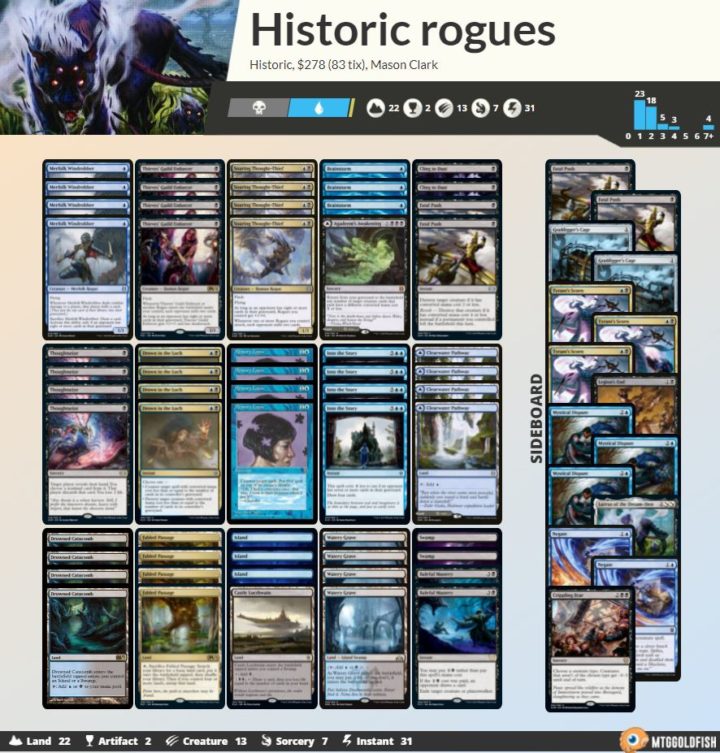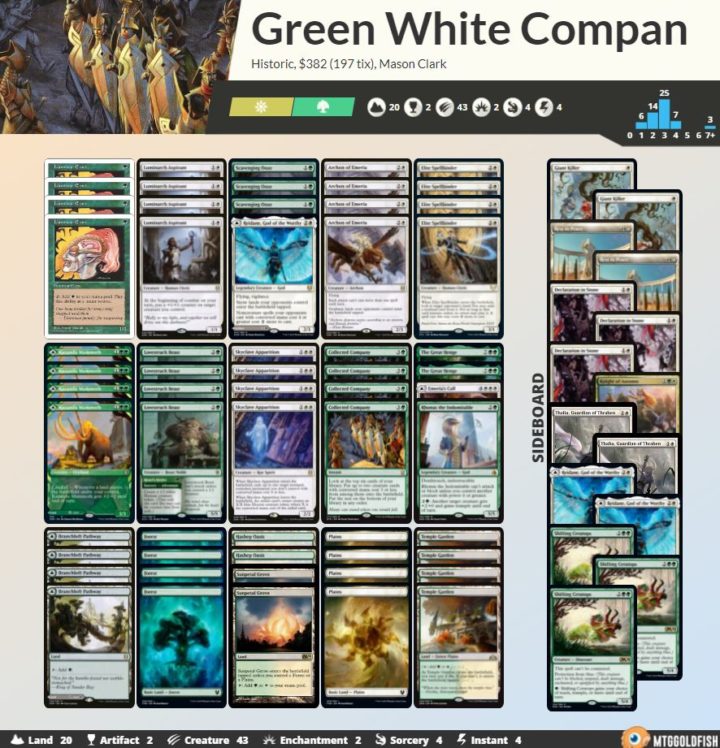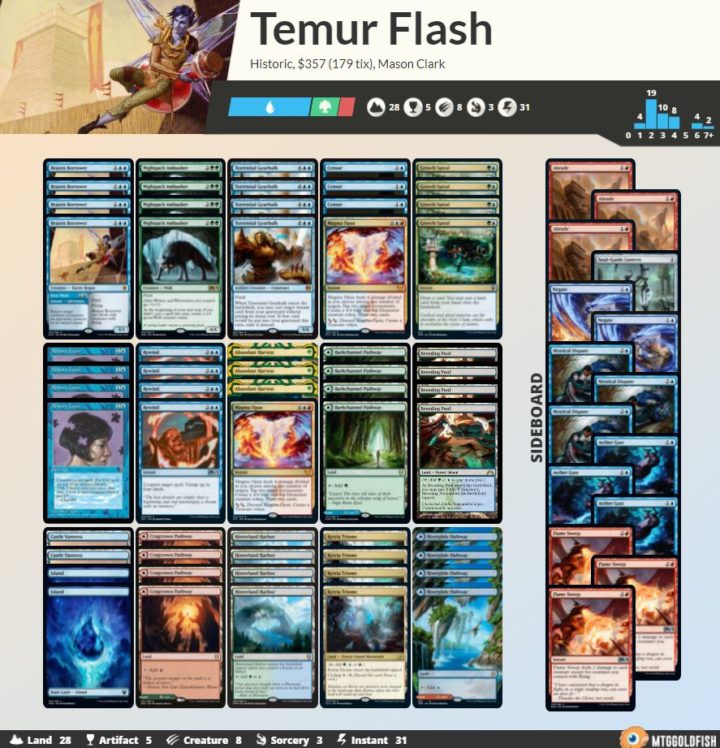Strixhaven has come to Arena, and along with it, the much talked-about Mystical Archive. This collection of spells has turbo-charged many Historic decks and completely changed the format as we know it. If you’re looking to get an edge in Historic and are not sure where to start, we have five decklists for you today that will help you climb to Mythic on the Arena ladder.
Rogues
No, your eyes aren’t deceiving you. Rogues is one of the most powerful decks in Historic right now for a few reasons.
With cards like Memory Lapse, Inquisition of Kozilek, and Baleful Mastery, Historic Rogues decks can consistently interact with opponents for very little mana. Memory Lapse is especially potent; it’s basically a “build your own Counterspell” in combination with the deck’s mill synergies. But the main reason Rogues is starting to see success is because so many Historic players are playing powerful cards at higher mana costs. When your opponents are all trying to resolve four- and five-mana cards, it’s very easy to punish them with your hyper-efficient answers.
Historic has lacked a real tempo deck for a while. Decks like Mono-Blue were just too weak to aggressive decks to ever break through, but Rogues’ efficient removal and discard spells give it a real shot. Rogues is excelling at punishing the greediest midrange decks right now, and if you’re a skilled player looking to quickly get to Mythic, Rogues is one of the best choices.
Blue-Green Taking Turns
Before the release of Strixhaven, many players worried about Time Warp warping the Historic format. Since its introduction, Taking Turns decks haven’t completely taken over, but they’re still a force to be reckoned with. These decks aim to set up situations where you can take two or three turns in a row and use Nissa, Who Shakes the World to generate 3/3 attackers. And that’s just a modest example of what the deck can do. I’ve often taken six or seven turns in a row and could have taken more if I needed to.
The build I’m highlighting today is very much meant for ladder. You’re trying to forgo interacting with your opponent most of the game and just execute your game plan. There are other builds that opt for more interaction; I’ve seen a Bant build that has both Wrath of God and Memory Lapse. While these builds could become the default in a month or two, a more noninteractive strategy seems best right now given the current breadth of decks in the format. In the main deck, I’ve opted for two pieces of interaction: Haze of Pollen, which often doubles as a Time Warp and has cycling; and a single Commit//Memory, which allows you to refuel in the late game. Unlike cards like Wrath of God, these modal answer spells will rarely rot in your hand.
Turns isn’t for everyone, but it’s a powerful deck that always forces your opponent to have the correct answers. If you’re interested in this deck, check back on Friday for Ally Warfield’s in-depth guide.
Rakdos Arcanist
Rakdos Arcanist has been a solid player in Historic for a long time now. It’s rarely been in the spotlight, thanks to decks like Sultai and Jund Food, but Mystical Archive has transformed it into the midrange deck of choice in current Historic.
Faithless Looting has been the biggest upgrade from Mystical Archive. This deck doesn’t have a lot to do with its lands, and Looting provides some much-needed flood insurance. While this deck still wants five or six lands in play, it now can choose to start holding those lands in the hope of exchanging them for real spells. This deck also relies heavily on discard spells, which get less effective the longer the game goes, but now we can exchange those cards for new ones, too.
Looting also allows Arcanist decks to turbo out Kroxa. Kroxa has always been a powerful closer in these decks, but you often had trouble casting it on turn four. Now, thanks to Looting, you can easily get Kroxa onto the battlefield early, and in the late game, you can keep casting Kroxa if your opponent has removal to deal with it. It’s no Uro, but it’s still a very hard card to beat.
Inquisition of Kozilek is the other big addition to Arcanist decks. While we aren’t playing the full four here, just having more discard spells to play on turn one is a good thing. Your best openings are often “turn one discard spell, turn two Dreadhorde Arcanist,” and having more ways to consistently do that is a huge plus. Inquisition is also the best discard spell for breaking up aggressive decks’ game plans, since it’s often relevant and won’t compromise your life total like Thoughtseize.
The last big get for this deck is Chaos Warp. This card hasn’t been on too many players’ radars, but for graveyard-heavy decks like this, it’s worth some serious consideration. Its ability to answer any problematic permanent makes it a great one-of in the sideboard. It’s never really dead, and most of the time, it will turn their hate card into a land. In the past, you often had to predict what hate cards your opponents might have and hedge on sideboarding; now, you’ll be caught with the wrong answer much less often.
Many players are giving Historic a try because they want to cast their favorite Legacy all-stars from Mystical Archive. If you want to recapture the joy of playing Dreadhorde Arcanist and cheap, interactive spells, here’s your chance.
Green-White Company
Players have often branded these sorts of decks as underpowered and clunky, but with Jund Food on the downswing, Collected Company decks have much more room to breathe. Green-White Company doesn’t have to be a Yasharn deck if it doesn’t want to be. Instead, it gets to play an aggressive/disruptive game plan that forces opponents onto the back foot — which is one of the biggest reasons why it’s performing well right now. With so many people exploring new, expensive spells, the format is ripe for a deck like this to step in and take over.
Elite Spellbinder is the only addition to this deck worth noting, but it’s been a great one. This card excels at the two things Green-White Company wants to do: apply pressure to life totals and throw opponents’ plans off. But the remaining cards in the deck are nothing to sneeze at, either: Skyclave Apparition and Reidane keep opponents from effectively developing their plans. Combine all this disruption with mana-optimizing cards like Llanowar Elves and Collected Company, and you have yourself a powerful deck.
Temur Flash
This last deck is a little divisive. It’s a tempo deck, sort of like Rogues, but with a much heavier curve. This comes with some strengths and some weaknesses, so let’s start with the strengths.
Unlike Rogues, Temur Flash’s cards are individually powerful and don’t require any real setup. The only counterexample is Torrential Gearhulk, but casting most any spell in this deck with Gearhulk is useful. Cards like Nightpack Ambusher and Magma Opus are game-ending cards — especially in combination with Gearhulk, in the latter case — which will allow your deck to more easily catch up from behind. This deck also plays a very high land count, which makes your “land, go” strategy very viable.
While this deck can easily play a “flash” style of game, that’s often by necessity. This deck plays many cards that have a high mana value, and that can get tricky if people are trying to go underneath you. You need to get to four mana on turn four, which is sometimes a liability. The other big knock against this deck is that wins often depend more on play skill than card quality. Your cards are stronger and clunkier than the average Rogue card, but that also means you need to focus on optimizing them. One bad attack from the opponent and your Nightpack Ambusher will be game-winning, but if they hold back, you might be in a much worse position.
All in all, I’m happy with this version of Flash, mostly due to the low mana value of its spells compared to other lists. I think a strong player can easily climb to Mythic with this deck, flaws and all.
***
That does it for this Historic decklist roundup. I hope you enjoy playing Historic this week! Tweet at @masoneclark and @card_kingdom and let us know which deck you enjoyed most.

Mason Clark is a grinder in every corner of the game who has played at the pro level and on the SCG Tour with Team Nova. Whether he’s competing in Standard, Historic or Modern, Mason plays with one goal in mind: to be a better player than he was the day before. Check out his podcast, Constructed Criticism, and catch his streams on Twitch.






